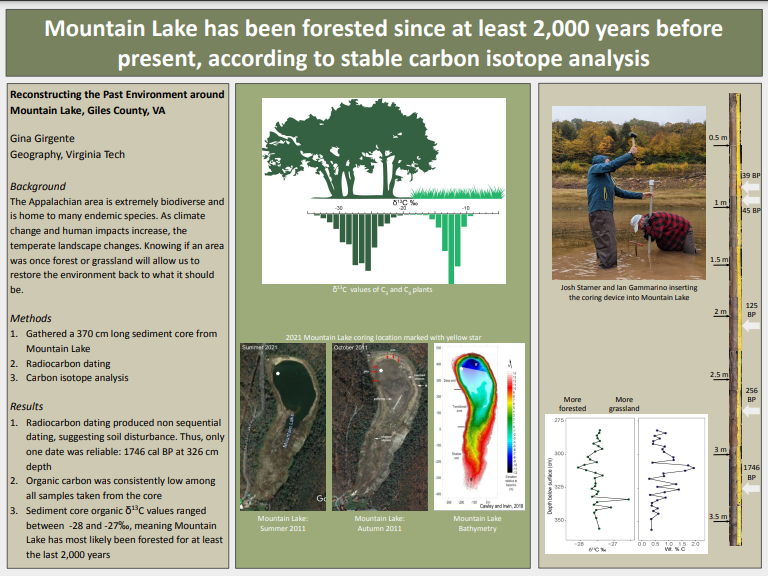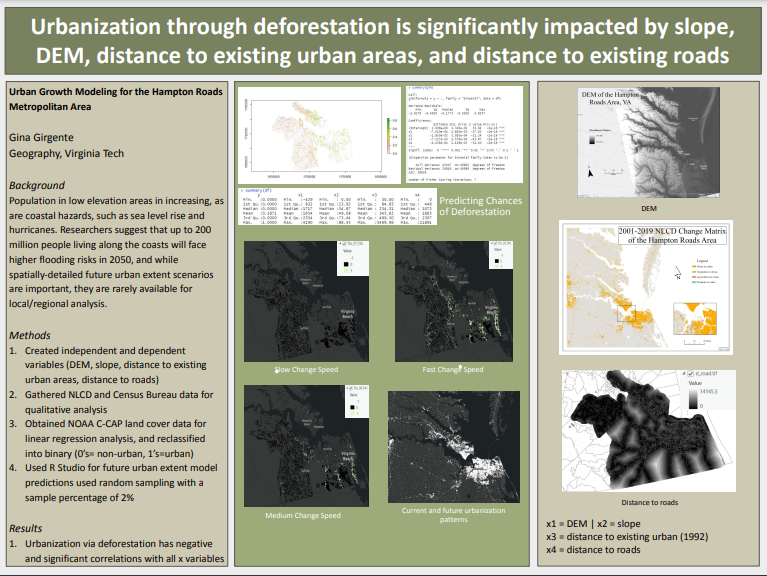Past Research

University of Denver
My capstone topic is not yet finalized.Virginia Tech
I engaged in three undergraduate research projects throughout two of the three years I spent at Virginia Tech. I presented two at the Dennis Dean Undergraduate Research Conference, was funded through a fellowship for one, and the third has been published in a subjournal of Nature.
Research in the geosciences: paleocology, paleoclimatology, biogeography, stable isotope analysis
This research was done under Dr. Rachel Reid and Dr. Lisa Kennedy. I began as a geoscience technician for
one year, then worked with my professors to create a sub-project that I could do individual research with for
credit. It was presented at the Dennis Dean conference. My individual research information is below:
Title: Reconstructing the Past Environment around Mountain Lake, Giles County, VA
Abstract: Very few natural lakes occur in the Appalachian Mountains, one of the most biologically diverse regions in the temperate world, but Mountain Lake in Giles County, Virginia, is an exception. Sediments accumulating on the lake bed provide an opportunity to study past climate and environment in this high conservation value region. Paleoenvironmental records are needed in particular to inform estimates of the past extent of grassland habitats, as these habitats are especially threatened today. This research uses carbon isotope values measured in sediment cores collected from Mountain Lake to reconstruct past vegetation dynamics in the area around the lake. Plant carbon isotope values are driven primarily by their photosynthetic pathways with C3 plants (most trees and shrubs) having considerably lower values than C4 plants, which are primarily grasses (averaging -27‰ vs -12‰, respectively). Decreases in lake sediment d13C values, therefore, provide evidence for more forest-like vegetation in the surrounding area, whereas increases suggest more grassland. We collected a 370 cm long sediment core from Mountain Lake, which dates to 1746 cal BP at 326 cm depth. We then extracted organic carbon from the sediments (mostly dead plant matter) for isotopic analysis, which was completed in the Stable Isotope Lab in the Department of Geosciences. d13C values measured between -28 and -27‰, suggesting that the area has been forested since at least 2,000 years before present.
Research in future urban extent: GIS, linear regression, coding in R, ArcGIS, change matrices
This research was done under Dr. Yang Shao for credit. It was presented at the Dennis Dean conference
and funded by a fellowship from the College of Natural Resources and Environement at Virginia Tech.
My research information is below:
Title: Urban Growth Modeling for Selected Coastal Cities of the Eastern U.S.
Abstract: Coastal ecosystems are under increasing pressure from population and urban growth, sea level rise, and climate change. Reliable models of these changes can help land/water managers and decision-makers plan for and mitigate undesirable outcomes to better meet societal needs. Focusing on the urban growth component, the main objective of this research is to develop a simulation model for coastal urban areas with meaningful interpretation and inference. Land cover products from NOAA C-CAP and NLCDs are used to identify forest-urban and agricultural-urban change locations from 1992-2019. A number of geographical and social variables are assembled to model urban changes using logistic regression model. These explanatory variables include elevation, slope, distance to road, distance to existing urban, and population density. Using the resultant urban change probabilities from logistic regression models, we further evaluate various growth scenarios such as business as usual, growth as planned, and resilient growth for 2020-2050. The model development initially focuses on Hampton Roads Metropolitan Statistical Area, VA. However, the modeling framework and data requirement is generally applicable and transferable to other coastal cities in the eastern US. Results from urban growth simulation models can be combined with future sea level rise scenarios for more in-depth analysis.
Research in Generative AI: GIS, quantitative methods in GIS, GeoDa, ArcGIS, coding in R, ChatGPT
This research was done with Dr. Junghwan Kim and Carmen Atkins, a PhD student at Virginia Tech.
The research information is below:
Title: Generative AI tools can enhance climate literacy but must be checked for biases and inaccuracies
Abstract: In the face of climate change, climate literacy is becoming increasingly important. With wide access to generative AI tools, such as OpenAI’s ChatGPT, we explore the potential of AI platforms for ordinary citizens asking climate literacy questions. Here, we focus on a global scale and collect responses from ChatGPT (GPT-3.5 and GPT-4) on climate change-related hazard prompts over multiple iterations by utilizing the OpenAI’s API and comparing the results with credible hazard risk indices. We find a general sense of agreement in comparisons and consistency in ChatGPT over the iterations. GPT-4 displayed fewer errors than GPT-3.5. Generative AI tools may be used in climate literacy, a timely topic of importance, but must be scrutinized for potential biases and inaccuracies moving forward and considered in a social context. Future work should identify and disseminate best practices for optimal use across various generative AI tools.Publishing information: Atkins, C., Girgente, G., Shirzaei, M. et al. Generative AI tools can enhance climate literacy but must be checked for biases and inaccuracies. Commun Earth Environ 5, 226 (2024). https://doi.org/10.1038/s43247-024-01392-w